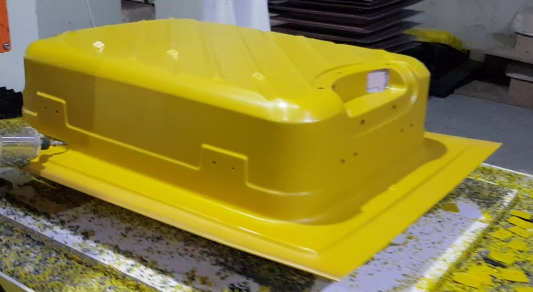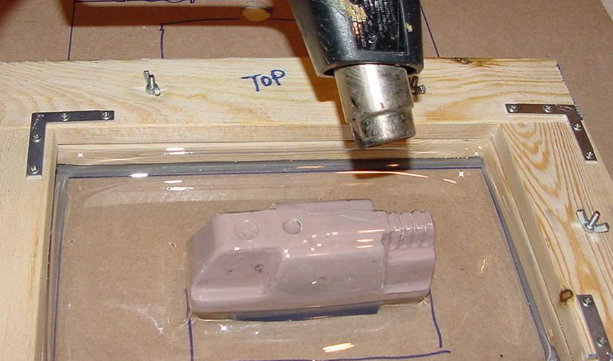Vacuum forming involves heating a plastic sheet, placing it over a mold, and using a vacuum to form it into the desired shape.

Materials Used in Vacuum Forming
Vacuum forming, a versatile and cost-effective method, primarily utilizes thermoplastics. These materials, when heated, become pliable and can be shaped over molds.
Types of Thermoplastics
- Acrylonitrile Butadiene Styrene (ABS): Known for its toughness and impact resistance, ABS is widely used for automotive, electronics, and consumer goods. It offers a balance between cost and performance.
- Polystyrene (PS): Lightweight and easy to shape, PS is ideal for disposable containers, model kits, and CD cases. Its low cost makes it popular for large-scale applications.
- Polyethylene (PE): This common plastic, used in bottles and containers, boasts high durability and flexibility. PE comes in various densities, affecting its strength and rigidity.
- Polyvinyl Chloride (PVC): PVC’s versatility extends from plumbing pipes to medical devices. It’s known for its chemical resistance and flame retardancy, making it suitable for a wide range of applications.
- Polycarbonate (PC): Renowned for its high impact strength and transparency, PC serves well in applications requiring clarity and toughness, such as protective covers and eyewear lenses.
Material Selection Criteria
- Strength and Durability: Select materials based on the required strength and durability of the final product. ABS and Polycarbonate are excellent for high-strength applications.
- Cost Efficiency: For budget-sensitive projects, opt for Polystyrene or Polyethylene, which offer a good balance between performance and cost.
- Chemical Resistance: PVC and Polyethylene are preferable in environments where chemical exposure is a concern.
- Thermal Properties: Consider the operating temperature range of the final product. Polycarbonate withstands higher temperatures, whereas ABS is more suitable for moderate ranges.
- Aesthetic Qualities: For applications needing visual appeal, use ABS or Polycarbonate for their finish and colorability.
Equipment and Tools
The right equipment and tools are crucial for efficient and quality vacuum forming. This includes selecting a suitable vacuum forming machine and various essential tools and accessories.
Basic Vacuum Forming Machine
- Heating System: Essential for softening the thermoplastic sheets. Typically, infrared heaters are common due to their efficiency in uniformly heating the material.
- Vacuum Pump: Creates the suction necessary to mold the plastic onto the form. A high-quality pump ensures speed and consistency in forming.
- Frame for Holding Plastic Sheets: Provides stability and even pressure during the forming process. Sizes vary based on project requirements, impacting the overall machine size and cost.
- Control Panel: Manages temperature, vacuum pressure, and cycle time. Advanced machines offer precise digital controls for consistency and quality.
- Build and Design: Machines range from simple manual desktop models to large automated systems. The choice depends on production volume, budget, and space constraints.
Essential Tools and Accessories
- Molds and Forms: Often made from wood, aluminum, or resin. The complexity and finish of the mold directly affect the quality of the final product.
- Cutting Tools: Precision cutting tools like jigsaws or CNC routers are used for trimming excess plastic.
- Finishing Tools: Sanders, drills, and polishers provide the final touches, ensuring a clean and professional finish.
- Safety Gear: Includes heat-resistant gloves, safety glasses, and sometimes face shields, crucial for protecting operators from heat and plastic shavings.
- Thermometers and Pyrometers: Monitor the temperature of the plastic sheet, crucial for achieving optimal forming conditions.
The Vacuum Forming Process
The vacuum forming process transforms a flat plastic sheet into a three-dimensional object through a series of controlled steps. This process involves preparing the plastic sheet, heating it, forming it over a mold, and then cooling it to retain its shape.
Preparing the Plastic Sheet
- Selection of Material: Choose a thermoplastic sheet based on the final product’s requirements regarding strength, flexibility, and appearance. Common choices include ABS, Polystyrene, and PVC.
- Cutting to Size: Trim the sheet to fit the machine’s frame using precise cutting tools. This step is crucial to ensure an even and efficient forming process.
- Securing the Sheet: Place the plastic sheet in the holding frame of the vacuum forming machine. Ensure it is tight and even to prevent any warping or irregularities during the heating phase.
Heating, Forming, and Cooling Phases
- Heating: Use infrared heaters to warm the plastic sheet to its forming temperature. The temperature varies based on the material – for instance, ABS requires approximately 160-270°C. Consistent heating is vital for uniform formability.
- Forming: Once heated, quickly transfer the plastic over the mold. Activate the vacuum pump to draw out air and press the plastic tightly against the mold. This stage is critical for capturing the mold’s details and shapes.
- Cooling: After forming, cool the plastic to solidify its shape. Cooling times vary based on the thickness and type of plastic but typically range from a few seconds to several minutes. Use fans or cool air blasts for quicker cooling.
- Release and Finish: Once cooled, release the plastic part from the mold. Trim any excess material and perform any needed finishing touches, like sanding or painting.

Design Considerations
Proper design considerations are crucial in vacuum forming to ensure the production of high-quality parts. This includes understanding mold design principles and the factors that affect the quality of formed parts.
Mold Design Principles
- Material Selection for Molds: Choose materials based on the prototype’s complexity and production volume. Common materials include wood for prototypes, aluminum for medium runs, and steel for high-volume production.
- Undercuts and Draft Angles: Design molds with appropriate draft angles to ease part removal. Avoid deep undercuts which can complicate the forming process and damage the mold or plastic.
- Surface Detail and Texture: Incorporate desired textures and fine details in the mold design, as vacuum forming can capture these intricacies effectively.
- Venting and Air Channels: Ensure the mold has proper venting to allow air to escape during the forming process, ensuring a tight fit between the plastic sheet and the mold.
Factors Affecting the Quality of Formed Parts
- Material Thickness and Consistency: Uniform thickness in the plastic sheet ensures even forming and reduces the risk of weak spots or defects.
- Temperature Control: Precise temperature control is essential for consistent material behavior. Overheating can lead to degradation, while insufficient heating can cause incomplete forming.
- Mold Precision: The accuracy of the mold’s dimensions and surface finish directly impacts the quality of the final part. Precision machining of molds is often necessary for complex or high-tolerance parts.
Troubleshooting and Common Issues
Understanding common issues and their solutions in vacuum forming is vital for maintaining efficiency and part quality.
Identifying and Solving Problems
- Webbing: Caused by excessive material sagging or low vacuum pressure. Solution: Increase the heating time or temperature, and ensure strong vacuum pressure.
- Poor Detail Transfer: Occurs when the plastic does not conform tightly to the mold. Solution: Check for adequate vacuum pressure and proper mold venting.
- Thinning: Happens when the plastic stretches too much, especially in deep molds. Solution: Use thicker material or redesign the mold to reduce depth.
Preventive Measures and Best Practices
- Regular Equipment Maintenance: Keep the vacuum forming machine and tools in good working condition to prevent malfunctions and inconsistencies.
- Material Handling: Store plastic sheets in a controlled environment to prevent warping or moisture absorption, which can affect forming quality.
- Training and Documentation: Ensure operators are well-trained and follow standard operating procedures to maintain consistency in the forming process.


